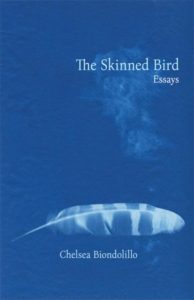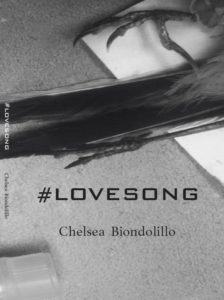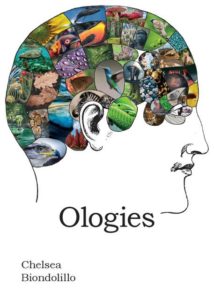The Skinned Bird: essays – Get a copy!

Chelsea Biondolillo’s The Skinned Bird is nothing short of breathtaking. Between poetry and prose, between flight and feet in the dirt, between feather and bone, the stories open up what we mean when we say being, steal your breath, and bring you back to life so that we might yet remember the risk and beauty involved in becoming. We could all use a new way to imagine becoming just now. Chelsea forges a path through imagination, science, the natural world, and language back to the heart of all things. I will read this book into forever. The Skinned Bird is tattooed on my heart.
– Lidia Yuknavitch, author of The Book of Joan
Sometimes when a human is truly an animal, their thinking patterns shift in fundamental ways, absorbing the color here and the systems within systems, to the point where they feel alienated from humans and the human part of themselves. The ache and dizziness of pulling these back into an integrated body and psychology is a story only a few of us can tell. Luckily, Chelsea Biondolillo is here to walk us through that process with no apology, only reverence.
– Kristin Hersh, musician & author of Rat Girl
Birds fill this book. But The Skinned Bird is also full of music, silence, rain, deserts and desertion. Chelsea Biondolillo shows us through science, memory, an updraft of questioning, and a flicker of answers how we learn and relearn how to sing. Like the space feathers need between them, Biondolillo gives us the space inside these essays for the air to flow and lift. Don’t worry if there is a pause. Biondolillo will stitch you in. Skinned Bird is a brilliant dive into how deeply we can love people and place and dirt and birds and air. And how we sometimes have to let go of all of that to truly fly.
– Nicole Walker, author of Sustainability, A Love Story
That every bird has on its chest a featherless patch ideal for our incision, that we learn our songs in the phrases our families hold aloft and, once each phrase is learned, repeat it as though our own invention. Chelsea Biondolillo doesn’t shy away from how the figures of our childhood may, and do, compose our adulthood. At the same time, Biondolillo’s lyric–sometimes fragmented, sometimes purposefully obscured, and other times replete unto bursting–essays hold open the moment where a long-repeated note may slip or twist, a new note sound. In a new home, a new city, or the final walk on the familiar towpath, we might alter our song just enough that it continues to contain our history and finally ushers us into the vast expanse of our future.
– Danielle Pafunda, author of The Book of Scab
Chelsea Biondolillo’s The Skinned Bird seamlessly weaves science and intuition into text, image and diagram that allows us to travel wild-eyed and headfirst into this deliberate and hopeful repurposing of trauma and loss. We are transfixed by the baby bird who leaves a perilously broken nest to finally be able to see, then sing, and through the sharing of these songs, we manage to finally hear our own.
– Joanne Dugan, visual artist & author
#Lovesong (2016) – Get a copy!
 #Lovesong is deeply lyrical work; a collage of photographs, found text, and micro-essay that explores love and loss in the inimitable voice of Chelsea Biondolillo, whose writing is always somehow both wry and tender.
#Lovesong is deeply lyrical work; a collage of photographs, found text, and micro-essay that explores love and loss in the inimitable voice of Chelsea Biondolillo, whose writing is always somehow both wry and tender.
– Sarah Einstein, Mot
#Ologies (2015) – Get a copy!

Biondolillo’s collection lacerates several human veins—gendered bodies, personal histories, scientific legacies–with a forceful & fearful precision. Ologies offers a pleasingly gruesome and vitally intimate dissection of the relationship between women, family, and the natural world. These are lyric essays of the sharpest order: astute, penetrating, incandescent.
– Will Slattery, managing editor Essay Daily
I’ve always been mesmerized by Chelsea Biondolillo’s ability to braid scientific data and observations with such longing, with such a vulnerable self. Here she creates a “taxonomy for all [her] dark fascinations,” inviting the reader not to turn away, but to stare, to linger in “how things were unmade.” These essays showcase the scalpel-like precision of her language along with her skills in setting disparate texts in conversation. “I wanted to understand something larger from the seeing,” she writes, which is exactly what these essays achieve through the lens of Biondolillo’s mind. Maybe the simplest way to say it is this: I’m a big fan.
– Jill Talbot, The Way We Weren’t: A Memoir